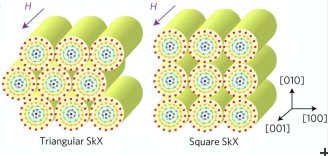Copyright 2012 neutronsources.org | All rights reserved. | Powered by FRM II | Imprint / Privacy Policy
New material offers stable spintronics
Skyrmions are electromagnetic vortices that can be used for spintronics. EPFL scientists have now discovered a material that can produce stable skyrmions in a wide range of temperatures, making it ideal for building devices.
Date: 04/10/2016
Source: actu.epfl.ch
Skyrmions are nanosized “vortices” that were recently discovered to occur in certain magnetic materials. As we learn more about their electromagnetic properties, skyrmions are showing promise as information carriers in low-power, dense-memory devices that depend on electron spin rather than charge – a next-generation field of “spintronics”. EPFL scientists have now identified a compound that can generate stable skyrmions that can be used for applications. The work is published in Nature Materials.
Skyrmions are not easy to control, and researchers have been trying to create stable skyrmions for years. Temperature is another factor; so far skyrmions only appeared in a narrow temperature range that is impractical for applications.
The Laboratory for Quantum Magnetism of Henrik Rønnow at EPFL, working with colleagues at RIKEN and Jonathan White at the Paul Scherrer Institut, have discovered a material in which skyrmions are stable even at high temperatures.
The material is a mix of cheap, abundant and non-toxic elements: cobalt, zinc, and manganese, and skyrmions appear at temperatures up to 130oC degrees, well above room temperature. Of course, for use in practical applications, a device must work across a wide range of temperatures above and below room temperature.
The researchers found that cooling the material at moderate rates actually allows the skyrmions to stay stable at lower temperatures. “In practice, this means we can start with a compound where skyrmions stabilize, say, below 400 K (130oC), and then, as long as we cool it moderately quickly, they will be metastable at any temperature below that, which is perfect for applications,” says Henrik Rønnow.
The material also exhibits a more fundamental peculiarity. When skyrmions appear, they normally form a kind of triangular lattice. In this material, however, the skyrmion lattice transforms into a square-like lattice. Going against all previous predictions, this is a first for the field. “It opens a new field of research into the lattice types possible for skyrmions,” says Rønnow.
This work represents a collaboration between EPFL, the Paul Scherrer Institut, RIKEN, and the University of Kyoto.
Reference:
Karube K, White JS, Reynolds N, Gavilano JL, Oike H, Kikkawa A, Kagawa F, Tokunaga Y, Rønnow HM, Tokura Y, Taguchi Y. Robust metastable skyrmions and their triangular-square lattice-structural transition in a high-temperature chiral magnet. Nature Materials 19 September 2016. DOI: 10.1038/nmat4752
